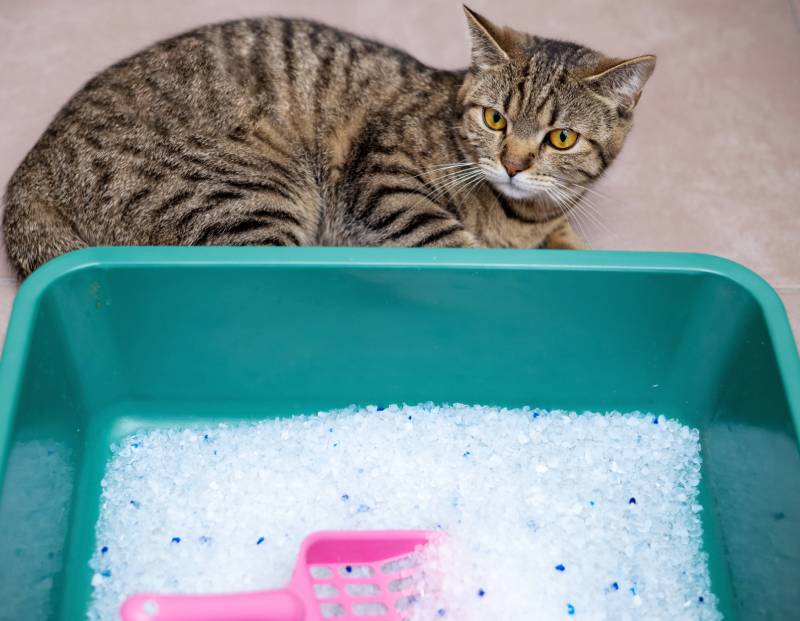Last Updated on June 3, 2024 by Annie Baldwin
Cat litter seems like a simple product — just some stuff to absorb odor and moisture in the litter box.
But when you look closer, you realize there are major environmental impacts from how cat litter is made and disposed of.
With growing interest in sustainability, it’s worth asking: is crystal cat litter really an eco-friendly choice?
Is Crystal Cat Litter Environmentally Friendly?

No, crystal cat litter is not environmentally friendly.
It is made of silica gel, which is not biodegradable.
The manufacturing process requires a lot of energy and creates pollution.
Crystal litter also cannot be composted and takes up space in landfills.
There are more eco-friendly natural litter options like pine and wheat.
Key Points
- Crystal litter is made of silica gel, which is not biodegradable or compostable.
- Manufacturing crystal litter is energy-intensive and creates pollution.
- Natural litter like pine and wheat are more environmentally friendly.
Our Opinion
Based on the research, I do not believe crystal cat litter can be considered environmentally friendly.
While it may have some advantages over clay litter, the fact that it is not biodegradable and requires so much energy to produce makes it unsustainable.
I think eco-conscious cat owners should choose a natural litter option like pine or wheat that will break down and avoid filling up landfills.
Crystal litter seems to just replace one environmental problem with another.
Is Crystal Cat Litter Made From Sustainable Materials?

Crystal cat litter is typically made from silica gel, a type of porous sand that is super absorbent but not biodegradable. The manufacturing process to make silica crystals uses a lot of energy and harsh chemicals. And while clay litter requires strip mining clay from the earth, crystal litter still consumes non-renewable resources and energy.
Once used, crystal litter’s plastic bag and silica gel beads will sit in a landfill forever. They don’t break down or support new growth like compostable natural litter. While the crystals are virtually dust-free and discourage mold, their lack of biodegradability is not good for the planet long-term.
So while crystal litter beats clay, it still has a negative impact compared to more natural and compostable options. For the most eco-friendly choice, look for plant-based litter made from sustainable materials like pine, wheat, or corn.
Does Crystal Cat Litter Require a Lot of Energy to Produce?

Yes, manufacturing crystal cat litter is an energy-intensive process. To make the silica gel beads, sand is first heated to extremely high temperatures of over 2,000°F. This requires large amounts of electricity or natural gas.
Next, various chemicals are used to remove impurities and alter the physical structure of the sand into porous beads. The crystals then need to be thoroughly washed and dried using more energy resources.
Additionally, most crystal litters come packaged in plastic bags. Producing the plastic resin and molding the bags consumes yet more electricity and fossil fuels.
In contrast, natural clay and plant-based litter require much less processing and energy to produce. The clay is simply dug up and dried. Plant materials like pine and wheat straw need minimal cleaning and shredding before use.
So while crystal litter might be convenient for controlling odors, the energy-intensive production has a larger carbon footprint than simpler clay or plant litter. Going with a more natural product is better for the planet.
What Are the Pros and Cons of Crystal Cat Litter for the Environment?
When weighing the environmental impact of crystal cat litter, there are some advantages but also significant drawbacks.
On the plus side, crystal litters are very effective at controlling odors thanks to the porous structure of the silica gel beads. This can reduce the frequency of litter changes.
The granules are also dust-free, which helps maintain indoor air quality. This benefits human and feline respiratory health.
However, there are considerable downsides for the planet. The raw materials and manufacturing process for crystal litter are energy-intensive. The beads do not biodegrade and end up in landfills.
Natural plant-based litters such as those made from pine, wheat, or corn are compostable. Over their lifecycle, these options are more sustainable.
For the environmentally-conscious cat owner, crystal litters are not the most eco-friendly choice. But they may better suit some cats’ sensitive noses while keeping odors at bay.
FAQ
What Is the Downside of Crystal Litter?
Crystal litter is not biodegradable and contains silica dust, which can be harmful if inhaled. The manufacturing process of crystal litter is also energy-intensive.
Is Crystal or Clay Litter Better for the Environment?
Neither crystal nor clay litter is particularly good for the environment. Clay litter requires strip mining clay and often contains chemical fragrances. Crystal litter is not biodegradable. Natural litter like pine and wheat are more eco-friendly.
Does Crystal Cat Litter Decompose?
No, crystal cat litter does not decompose because it is made of silica gel. It will remain in landfills indefinitely.
What Type of Litter Is Best for the Environment?
Natural litter like pine, wheat, and corn are the most environmentally friendly because they are biodegradable and renewable. Stay away from clay and crystal litter.
Conclusion
Overall, crystal cat litter is not environmentally friendly due to its lack of biodegradability and energy-intensive manufacturing process. Natural litters like pine and wheat are better options for eco-conscious cat owners. While crystal litter may have some advantages over clay, it ultimately ends up in landfills and has other concerning environmental impacts. When choosing cat litter, consider sustainability.
